Strategies For Building a Hybrid Workspace
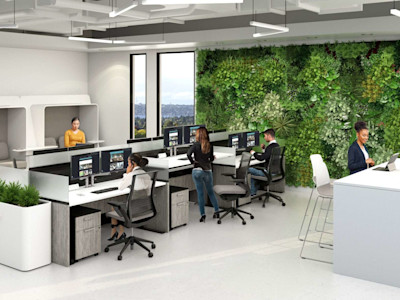
A hybrid working environment is a business model that blends remote and in-office work. The reasons for implementing this business practice vary. Some companies view it as an opportunity to increase efficiency and become more cost-effective. Staggering in-office attendance often creates a need for less physical office space. Other companies might provide a hybrid option to their employees as an employee benefit. A properly designed hybrid workspace provides a resource for employees to meet, collaborate, and perform work in an office setting. But it also needs to allow for in-office workers to work seamlessly with their remote team members. Our commercial office furniture can help design different spaces for different work purposes and interactions. And these areas provide workers with resources that can help them in and out of the office. There are several key elements to a hybrid space and the design depends solely on a worker’s needs.
What do Employees Need?
An employee needs the necessary tools and space to do their job. For some this may mean large, open collaborative workspaces. For others, this may mean private cubicles where they can work undisturbed. But the majority of the time, both types of spaces are needed at different times. The employee needs can be identified by the type of work they do. Here are a few questions to consider:
Do they work on collaborative projects often?
Does the person need a quiet space for focused work?
Is there often shoulder-to-shoulder mentoring happening?
How does the number of workers in my office vary?
Why do workers typically choose to come to the office?
Will desks be assigned or is seating flexible?
The answers to these questions can help guide the type of workspaces you will need in your office. While the answers differ for every organization, the following spaces are found in a typical hybrid workspace.
The Collaborative Space
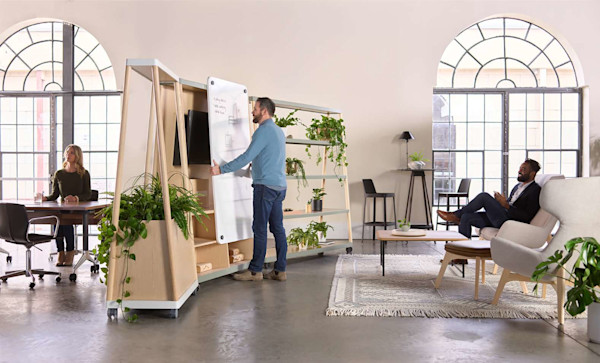
Technology needs to be a part of any collaborative area so that connections can be established.
Aesthetics, comfort, functionality, and amenities are all elements that need to be considered when designing a collaborative space. Great designs make workers feel welcomed to the space and encouraged to work together. These spaces often include lounge seating, to bring a bit of home to the office. A key to accommodating the hybrid workforce is flexibility. Moveable partitions help make spaces for smaller groups but when rearranged accommodate larger meetings.
The Personal Space
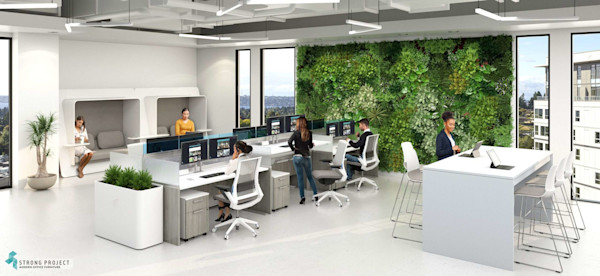
Provide adequate desk space and an environment that has minimal distractions and limited disruptions for detailed work.
Individual privacy pods are becoming more and more common in the workplace. Pods are either completely enclosed or partially, with both versions reducing noise. Some completely encapsulated pods have smart features such as independent climate control and can provide custom lighting. The level of privacy needed from a personal space depends on the work and the worker. No matter the type, include some form of personal workspace within a hybrid working environment.
Staying Connected
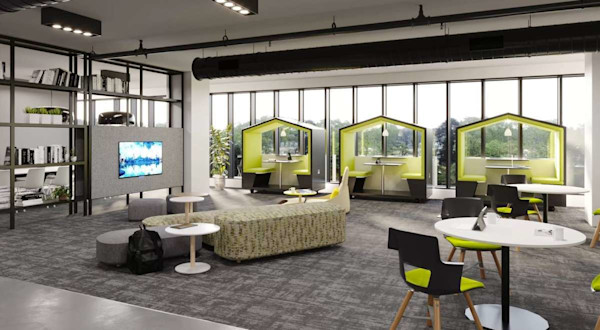
Common struggles for geographically separated teams include maintaining a sense of community and preserving company culture. Hybrid workplaces have a mix of in-office and remote employees that vary on any given day. Technology needs to be a part of any collaborative area so that connections can be established. This may come in the form of large screens or technology hookups for laptops.
Creating a cohesive space organized by use can help cut down on distractions and increase efficiency in the workplace.
Although a worker might not be in the office they still need to have channels to communicate with coworkers and, or management. Encouraging group chats, virtual lunches, and having the resources to do so helps incorporate employees working remotely. Some offices might have private areas where they can also conduct small meetings or one-on-ones. It is important to keep employees involved in the day-to-day even though they might not be in the office. Providing workers with the proper resources is necessary to keep employees connected.
Hybrid Workspace Zones
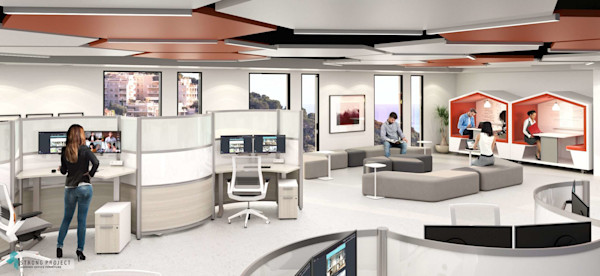
There are many different areas in the hybrid workspace that serve different purposes. It is helpful to think of these individual areas as zones. Creating zones throughout the office for different purposes can help with efficiency and productivity. A hybrid workspace can integrate focus zones, collaborative zones, and training zones, and workstations, and allow for team members to move between these spaces easily. The needs of hybrid workers change based on who is in the office and what their work priorities are for the day, so having zones for each type of work accommodates their needs. Creating a cohesive space organized by use can help cut down on distractions and increase efficiency in the workplace.
Many companies view hybrid work as an opportunity to increase efficiency and become more cost-effective.
When building a hybrid workspace it is important to keep a worker’s needs in mind. Does a worker need a lot of personal space? Is collaborative space more important? These are all questions that need to be asked. Providing employees with resources they may not be able to find outside of the office is necessary. Companies need to make adjustments to the office to meet the needs of the ever-growing hybrid workforce. While some businesses do not need as much space and are starting to downsize, other businesses are making better use of the space that they have. With fewer employees in the office, there is space to create an ideal working environment for a hybrid team. Is your office ready for a hybrid workforce? StrongProject can create a custom design to help your team thrive. Want to learn more about designing a hybrid office? Check out our comprehensive guide!



